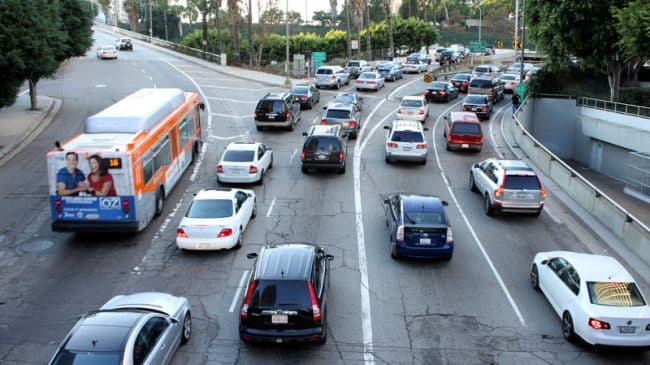Every year, the U.S. President releases his budget document for the following fiscal year. And similar to most every Commander-in-Chief before him, President Trump’s budget is a political document. But that hasn’t stopped the media from writing breathless news stories about the President’s proposal to decimate this and eliminate that. But the major reductions to transportation highlighted by many daily newspapers are not cuts at all, just changes in spending from discretionary to mandatory. Further, if the Trump Administration infrastructure package passes before June of 2018, which is highly likely, transportation funding will actually increase.
Trump certainly proposed changes to some departments: the Environmental Protection Agency sees a 31 percent decrease in funding that some see as draconian while the Defense Department sees a 9 percent increase in funding that it most certainly does not need.
In contrast to certain agencies such as EPA the supposed 13 percent decrease in transportation funding is relatively minor. Yet many in the Transportation world are sounding the alarm about the non-existent 13 percent decrease in transportation funding.While spending cuts are an out-of-this-world concept for many in Washington, Donald Trump’s DOT budget makes relatively small cuts to some questionable programs. In reality, it’s not the total funding but the losses to specific programs that are spurring the apoplectic meltdowns.
Most of DOTs budget (69 percent) is funded via mandatory budget authority. This includes any program with a dedicated trust fund, including the highway trust fund and airport improvement program. Since this is Congressionally dedicated money, President Trump could not make cuts to this funding even if he wanted.
While the budget technically cuts funding 3.1%, under the terms of the FAST Act, the mandatory budget authority increases by $2.4 billion, to $56.1 billion, the exact amount that Trump proposes cutting. As a result, the net change in President Trump’s budget is zero. The budget does freeze current spending, but it doesn’t cut it.
Additionally, Trump proposes some of the same ideas as President Obama. Not surprisingly, they generated much less press under the Obama Administration. The Obama Administration proposed shifting the TIGER Grants, New starts grants, Amtrak grants, the high-speed rail grant program and NHTSA vehicle safety expenses from the general fund discretionary program to mandatory budget authority. As Jeff Davis of Eno Transportation Weekly points out if transportation types had taken a closer look at the Obama Administration budget they would have realized that the net discretionary total funding dropped 19 percent from the Administration’s 2015 spending to the Administration’s 2016 budget. Obviously, any analysis that does not consider both discretionary funding and formula funding is flawed.
The President’s budget is just a suggestion. Congress will adopt whatever it wants. In 2016, President Obama’s 2017 budget proposed a $320 billion increase in funding for transportation, or a 10%, increase over 10 year to transform the how people and goods move through the U.S. Even Democrats thought the 2017 Obama budget proposal was completely worthless. And not one part of the President’s proposal became law. Trump does have a more sympathetic audience with Republican leaders in Congress. But no Legislature is going to rubber stamp what the Executive Branch does. Congress has the power of the purse strings and it members are going to use it as they see fit.
In reality, Trump’s budget is not about cutting programs but rather setting goals for transportation policy. Not everybody will embrace the transportation goals of the Trump Administration but at least the administration has set goals. First, the budget cuts administrative overhead. These cuts don’t affect transportation funding, and since personnel grew significantly during the Obama Administration, there is room for reductions.
Second, the budget stops the pointless fight against the free market. Reason Foundation is a proponent of the free market and the advantages that it brings to society. Regardless of personal political philosophy, the U.S. is a center-right country based on Capitalism and the free market. Efforts to control or reign in the market lead to negative economic effects. Regardless of arguments to the contrary, policymakers should start with a belief in the free market, not a tendency to battle it as was evident in the last administration.
Finally, the Administration wants to replace discretionary programs with mandatory programs. The administration believes that discretionary funding programs are less efficient because of political influence. Formula funds are by definition based on a formula that has political undertones as well. However, the Transportation Investment Generating Economic Recovery (TIGER) Program administered under the Obama Administration became needlessly political, evolving into moreof an administrative earmarking program than anything else. Given this abuse it is no surprise that the Trump Administration wants to end discretionary programs.
President Trump’s budget did a good job of aligning the proposed USDOT budget with his three goals, particularly goals two and three because the first goal does not cut any funding. The Elimination of the Essential Air Service Program, which subsidizes grossly unprofitable air routes fits in with the second point about fighting against the free market. As part of point two, the budget eliminates funding for Amtrak’s long distance corridors, which lose millions annually. However, it retains its support for the profitable Northeast Corridor and Northeast Regional trains as well as state routes. Ending the TIGER Grants program meshes with goal three and of replacing discretionary programs. Eliminating federal funding to transit fits in meshes with both goals two of a free market transportation solution and three of eliminating discretionary funding to new capital projects.

